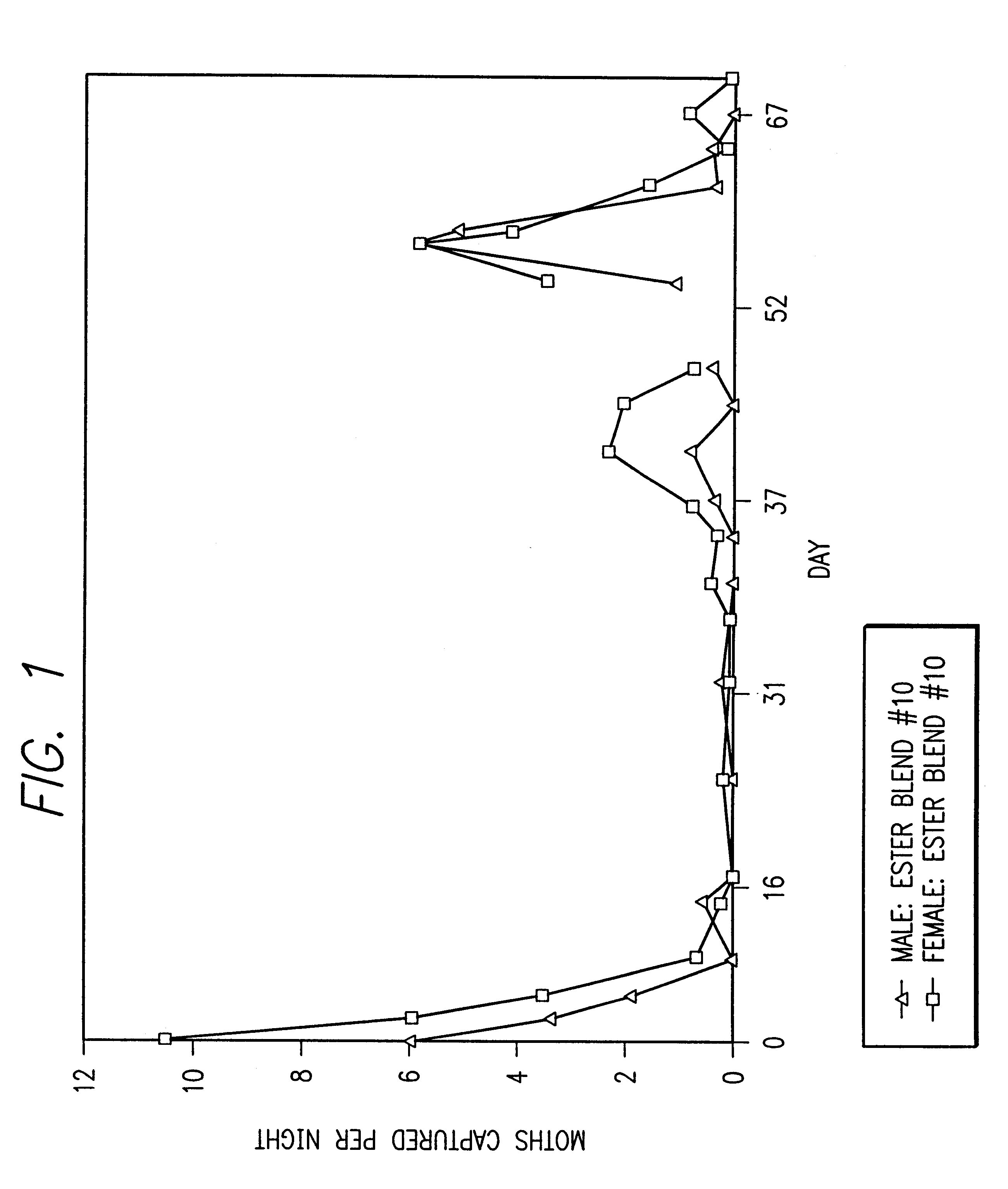Bisexual attractants, aggregants and arrestants for adults and larvae of codling moth and other species of lepidoptera
- Summary
- Abstract
- Description
- Claims
- Application Information
AI Technical Summary
Benefits of technology
Problems solved by technology
Method used
Image
Examples
example 1
Extraction and Analysis of Volatile Semiochemical Attractants
This example describes extraction, isolation and analysis procedures used to obtain individual volatile odors of various apple, pear or walnut varieties.
Both solvent extraction and headspace odor trapping were used for odor isolation and analysis of the complex odors of various apple varieties, Bartlett pears and English walnut varieties.
Stainless steel tubes packed with Tenax.RTM. adsorbent were used with a battery-powered small vacuum sampler pump to trap the volatile leaf and fruit odor emissions of various host-plant trees in the laboratory and orchard. The odor tubes were either extracted by solvent washes or thermally-desorbed onto a DB-1 capillary GC-MS system and compositionally analyzed. Differential compositional analysis identified almost 100 volatile compounds found in pome fruit odor but not in walnut odor.
Synthetic samples of 92 chemically-diverse pome fruit HPVs were variously mixed to create 23 distinct rec...
example 2
Behavioral Bioassays
This example describes behavioral bioassays used to determine the effect of host-plant volatiles on the insect pest.
To determine the effects of HPVs on both primary attraction and pheromone attraction of codling moths, two experiments were conducted: 1) tests of the inherent attractancy of the HPVs to both sexes of the codling moth, and 2) the preference of male codling moth for either pheromone alone or pheromone augmented with HPVs.
Inherent Attractancy Tests
Sticky traps (ICP and IIB traps, Trece, Inc. Salinas, Calif.) were baited with either extracts, blends of HPVs, or individual HPVs (>95% purity) that evaporated from impregnated rubber septa. HPV blends, or individual HPV compounds, were diluted in hexane and pipetted onto rubber septa at approximate doses of 10 mg / septum. A single treatment septum was placed in each sticky wing-trap, and hung approximately six meters high in the outer walnut canopy. Trap liners and treatment HPV septa were replaced every 10...
example 3
Purification of Bisexual Attractants
This example illustrates purification procedure suitable for purification of host plant volatiles of the invention.
1. Purification of (2E,4Z)-2,4-decadienoate Acid
A. Hydrolysis of Ethyl (2E,4Z)-2,4-decadienoate
An aqueous solution of sodium hydroxide (10%, 22 ml) was added to a solution of technical grade ethyl (2E,4Z)-2,4-decadienoate (10 g) in tetrahydrofuran (100 ml). The mixture was heated under reflux for 5 hours with rapid stirring in a nitrogen atmosphere. After allowing to cool to room temperature, tetrahydrofuran was removed on a rotary evaporator, the residue was diluted with water (100 ml), and acidified to pH2 with 6N HCl. The acid was extracted with ether (3.times.100 ml) and the combined extracts were washed with water (2.times.50 ml) and brine (50 ml) and dried using anhydrous magnesium sulfate. Removal of ether under reduced pressure gave (2E,4Z)-2,4-decadienoic acid. This product was used in the next step without further purificati...
PUM
| Property | Measurement | Unit |
|---|---|---|
| Mass | aaaaa | aaaaa |
| Mass | aaaaa | aaaaa |
| Fraction | aaaaa | aaaaa |
Abstract
Description
Claims
Application Information
 Login to View More
Login to View More - R&D
- Intellectual Property
- Life Sciences
- Materials
- Tech Scout
- Unparalleled Data Quality
- Higher Quality Content
- 60% Fewer Hallucinations
Browse by: Latest US Patents, China's latest patents, Technical Efficacy Thesaurus, Application Domain, Technology Topic, Popular Technical Reports.
© 2025 PatSnap. All rights reserved.Legal|Privacy policy|Modern Slavery Act Transparency Statement|Sitemap|About US| Contact US: help@patsnap.com



